Emotional Lability: All You Need to Know about It

Controlling emotions is one of the healthiest things in a human being’s life. This refers to a normal display of emotions depending on the situation and environment. However, people with behavioral conditions tend to experience intense emotional episodes. In addition, everyday life pressure leaves most people emotionally unstable, anxious, and stressed. As a result, they display exaggerated emotions or moods; a condition referred to as emotional lability. Understanding emotional lability can be a complex process because of its various diagnosis, causes, and treatment aspects. This article covers an in-depth description and updated knowledge required to know everything about emotional lability. If you are one of those suffering from it or relate to this mental state, keep reading to figure out the possible treatment and management options.
Proper mental health treatment can save you from emotional lability. Click the button below to book your appointment.
Emotional Lability Explained
Emotional lability is a feature of some psychiatric and neurological disorders. As mentioned above, victims may feel happy one moment and sad or angry the next without any triggers. These impulsive behaviors may trigger social interaction and relationships issues, often causing embarrassment or stress to the person involved.
Emotional Lability Definition
The term Liability originates from a Latin word called Labilis, meaning moving or tottering inconsistently. Thus, the term emotional lability represents a whole load of conditions characterized by reactivity and labile mood or effect. Emotional lability stands for inflated mood swings as a swift response to a situation in the pathology and medicine world. On the contrary, normal individuals display standard emotions like crying when sad or laughing during happy times. Other terms used to describe emotional lability include:
- Involuntary emotional expression disorder
- Affective lability
- Emotional incontinence
- Emotionalism
- Pathological laughing/ crying
- Pseudobulbar affect
Keep in mind that the ailment is more common in individuals with severe head injuries or pre-existing neurological challenges like bipolar disorder, borderline personality disorder, and others.
Is Emotional Lability a Mental Disorder?
Emotional lability is not a mental disorder but a symptom of multifactorial factors. Victims are often susceptible and react almost instantly to almost anything. Although mood swings are pretty normal in a human being, highly negative emotions should be a source of worry.
Is Emotional Lability the Same as Mood Swings?
The industry is laden with plenty of confusion surrounding emotional lability and moodiness. Mood swings are a normal part of life. This is not to say that everyone has mood swings, but many people experience a wide range of emotions now and then. In general, mood swings last for a short period and range from happy or irritable to sad or anxious. On the other hand, emotional lability refers to the sudden and drastic changes in emotion and affect. Sometimes, the condition occurs as a symptom of another disease such as bipolar disorder.
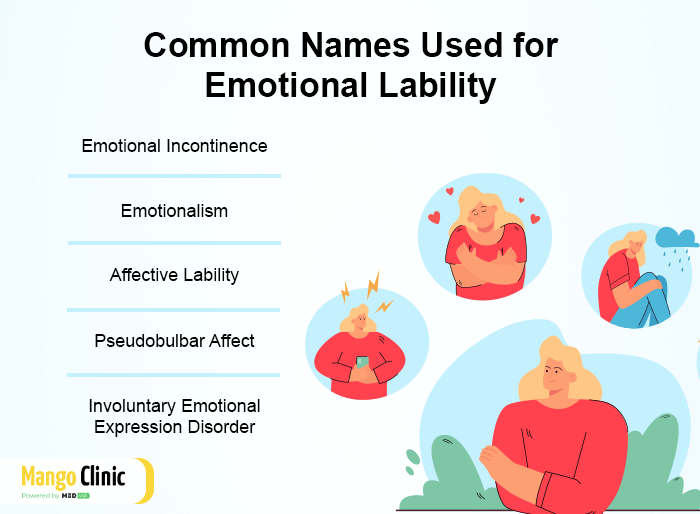
History of Emotional Lability
The term emotional lability became popular around 1832 when a French psychologist used it in his book ‘The Mechanism of Human Facial Expression’. The word initially described people with strange crying behaviors or unusual emotional traits such as extreme laughing, blushing, and trembling. Soon after, another psychologist known as Peter McKiller coined the word labile after intensive analysis on patients with labile temperaments.
Common Types of Emotional Lability
There are two essential kinds of emotional lability; Manic episodes and Dysphoric labile mood.
What Is Dysphoric Labile Mood?
Dysphoric labile mood is a type of mood disorder characterized by sudden, intense changes in mood. The mood swings sometimes can be severe enough to interfere with daily activities. The symptoms of dysphoric labile mood vary from person to person but often include emotional swings, from happiness to sadness, irritability, and anxiety. Take note that transition from one mood to another happens suddenly or continuously, several times in a day.
What Are Manic Episodes?
A manic episode lasts longer, sometimes running into days and not for short periods like in dysphoric labile mood swings. When in a manic state, people often have unrealistic beliefs about their abilities and powers. As a result, they take unnecessary risks like partying wild, spending money impulsively, or engaging in unsafe sex. Experts presume that these behaviors relate closely with bipolar disorder, which has similar symptoms. Other common signs noted on manic patients include heightened anger, racing thoughts, insomnia, euphoria, and agitation. Typically, patients display a high level of carelessness through the episodes.
Save yourself from different types of emotional lability. Click the button below to book your appointment.
Emotional Lability Signs and Symptoms
The most notable warning signs of emotional lability include excessive laughing and crying. These outbursts sometimes lead to unpredictable consequences that rub negatively on the patient and the people in their lives. While we have already mentioned common emotional lability symptoms, others include:
- Lack of emotional traits in between episodes. Here, emotions happen simultaneously when transitioning from one mood to another. In some instances, patients may laugh and cry at the same time.
- Wrong display of emotions. For instance, sufferers may start laughing or giggling during a solemn function like a burial for no apparent reason.
- A sudden outburst of emotions like constant crying for no reason.
- No emotional symptoms in between emotional lability episodes.
Most Significant Signs of Emotional Lability
Unsuitable Responses
One of the more troubling aspects of emotional lability is how it affects people. A noteworthy feature is inappropriate responses such as laughter at a funeral. Sometimes, these emotions do not need to display opposite feelings, but patients can also display severe anxiety attacks if things fail to go as planned.
Passionate Reactions
Usually, there is no valid basis for sudden mood transitions and outbursts in emotional lability patients. In fact, experts developed the term “emotional lability” because these individuals are prone – sometimes without warning to undergo extreme shifts between happy or sad states. This situation is sometimes hard on relationships, especially if individuals are unaware of common triggers.
Controlling Intensified Emotions
The biggest downside of affective lability is the inability to control emotions and their intensity at the moment. Even after self-awakening, these patients simply can’t fit in without episodes of emotional outbursts. Hence, emotional lability victims have chaotic relations and selected friends, if any.
Is Emotional Lability an Indication of ADHD?
Emotional dysregulation and poor control of moods are common symptoms in ADHD patients. It is worth mentioning that the association between these conditions starts way back from early childhood, possibly persisting into adulthood. Despite all, emotional lability does not fall under listed ADHD symptoms in the DSM criteria. In a recent presentation at the 5th World Congress, Dr. Philip Aherson presented emotional lability and its prevalence in ADHD patients. Based on his report, he sensitizes that emotional lability can sometimes classify as a unique impairment in people living with ADHD. The significant link is that emotional lability patients responded extremely well when placed on ADHD treatment. This was quite clear when Philip and his team proposed a treatment experiment on some patients for approximately 12 weeks. When Philip anticipated treating ADHD prisoners with methylphenidate, he had no idea how it would work. Nonetheless, the results were nothing short of incredible. Further on, a new study suggests that the rate of occurrence of emotional lability is more harsh and severe in ADHD patients.
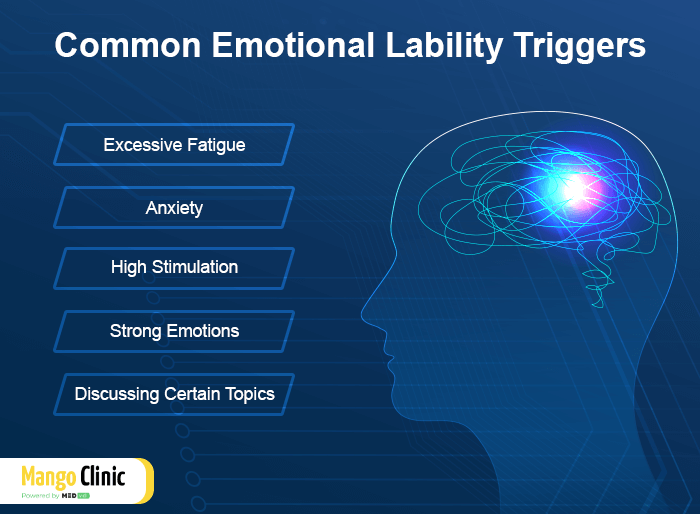
How Is Emotional Lability Diagnosed?
Diagnosing emotional lability can be tricky, as symptoms coincide with other mental health conditions like major depressive disorder. Currently, there are no approved diagnostic criteria for the ailment. Therefore, medics only diagnosed through a process of elimination and noticeable symptoms. To make a diagnosis, they will rule out other possible causes of a person’s emotional outburst like bipolar disorder, head injury, and thyroid dysfunction. Qualified therapists then ask intensive questions about the frequency and intensity of flare-ups. If doctors suspect lability, they usually order tests like brain scans to rule out other mental health issues like ADHD or schizophrenia. For this reason, recording mood swings and their intensity simplifies the entire diagnosing process. In addition, consider using the questionnaire below to test emotional lability.
| Common Questions | A | B | C |
| How often do you experience emotional outbursts episodes? | Never | Sometimes | Always |
| Do you suffer from an unexpected transition of emotions abruptly? | Never | Sometimes | Always |
| Have you ever laughed or cried uncontrollably in inappropriate situations? | Never | Sometimes | Always |
| Do you struggle to make sense of your feelings? | Never | Sometimes | Always |
| Are there incidents where you experience no symptoms in between emotional outbursts? | Never | Sometimes | Always |
| Do you feel guilty because of your behavior around other people? | Never | Sometimes | Always |
| How often do you manage to control the emotional intensity and mood swings? | Never | Sometimes | Always |
| Do you stay worried, especially when you go out of control? | Never | Sometimes | Always |
| Do people around you complain about your behavior and mood swings? | Never | Sometimes | Always |
Key Guide
A= 0 points
B=5 points
C=10 points
Total Scale
56-90=Severe
21-55= Moderate
0-20 = Normal to Mild
What Is ICD-10, and Why Is It Used?
ICD-10-CM is a set of medical codes used for diagnostic coding and reporting. Developed by the World Health Organization under HIPAA (Health Insurance Portability and Accountability Act), the code standardizes health diagnoses across international boundaries. The acronym represents International Classification of Diseases, Tenth Revision, and Clinical Modification. Experts use the code set to track disease statistics, mortality figures, outcomes, and billings. For individuals eager to learn about the latest emotional lability global trends, you can do so through ICD-10 code R45.86.
Contact us now to get treatment for associative symptoms of emotional lability. Click the banner below to book your appointment.
What Triggers Emotional Lability?
Currently, there is no definitive answer to this question. Nevertheless, since emotional lability is a neurological ailment, listed below are the primary causes:
- Mental health problems like bipolar disorder, major depressive disorder, or anxiety disorders
- Medical problems like head injury, thyroid dysfunction, or drug side effects
- Psychological stressors like a death in the family or divorce
- Environmental factors like an unstable home environment or school bullying
The following attributes also contribute to emotional lability development:
Emotional Lability after Stroke
According to the National Stroke Association, over 50% of stroke survivors display emotional lability symptoms. This mental health condition starts from a lack of oxygen and nutrients to the brain, leading to a slow death of cells. Once stroke strikes, it is indispensable to receive medical attention right away to prevent emotional lability or other related complications, like paralysis. Unfortunately, medics fail to pinpoint the primary connection and link of these conditions. Still, some experts presume that a stroke attack probably alters or damages connections between the brain and frontal lobes.
What Neurological Conditions Cause Emotional Lability?
Multiple Sclerosis (MS)
This severe neurological disorder affects the central nervous system (CNS). Here, various disruptions could damage the myelin sheath, which covers nerve fibers and helps send signals along with them safely. Thus, most MS patients may experience multiple emotional lability signs like constant grief, exaggerated irritability, worry, or moodiness.
Dementia/ Alzheimer’s disease
These are neurological disorders with a progressive decline in brain functions. The condition may start from minor memory loss, cognition difficulties, to ultimate functional disability. Lack of motivation and changes in behavior patterns are some symptoms that demonstrate this illness’s strong association with emotional control.
Amyotrophic Lateral Sclerosis
Also recognized as Lou Gehrig’s disease, the disease revolves around brain damage and spinal cord complications. In most cases, the condition cuts down motor function in affected individuals. Due to the trauma, patients may display uncontrollable emotional inconsistency. Extensive research indicates that people suffering from this condition display more frequent mood swings and feelings of sadness/ grief and anxiety disorder than others. Other likely grounds for emotional lability are:

Medication Side Effects: Strong medications like antidepressants sometimes trigger adverse reactions prone to cause emotional lability.
Pseudobulbar Affect: This often happens after neuronal or brain damages caused by trauma and infections. Patients have uncontrolled laughing and crying symptoms.
Substance Abuse: This refers to illegal drugs like heroin, cocaine, marijuana, alcohol, ecstasy, which unfortunately can trigger mood swings.
Mood Disorders: Mental health conditions characterized by mood instability like depression, bipolar disorder, and borderline personality disorder also result in emotional lability.
What Are the General Impacts of Emotional Lability?
Intense changes of emotions in emotional lability can be so sudden and unpredictable, often leaving patients in a dilemma on how to cope with them. Patients with emotional lability may feel like they are on an emotional roller coaster, impacting their work, social life, and personal relationships. Additionally, they may feel more like failures compared to healthy individuals. Moreover, emotional lability sufferers report strong emotions at inappropriate times, like crying during happy times, which eventually embarrasses them or messes with their self-esteem. Hence, these victims may be more vulnerable to suicidal thoughts and self-harming behaviors. Regrettably, affected victims often steer clear of social gatherings, afraid to expose their labile moods. The thumb rule is to seek professional help early enough to avoid embarrassment and other repercussions.
The unpredictable emotions in emotional lability can also lead to various physical problems. Patients sometimes feel an increase in heart rate, sweating, and muscle tension when faced with strong emotions. These physical symptoms may further aggravate the emotional distress that the patient is experiencing. Finally, emotional randomness makes diagnosis a complicated process. For instance, medics may find it challenging to properly diagnose emotional lability on a bipolar patient who experiences rapid mood swings. Given that borderline personality disorder and other conditions share similar symptoms, a not very keen therapist may misdiagnose the illness. Overall, significant consequences of emotional lability are low self-esteem, social isolation, extreme anger, persistent grief, wild happiness, suicidal thoughts, or self-harming actions. Bear in mind, emotional lability can significantly impact patients’ lives and should be taken seriously.
Emotional lability can leave a significant impact on your life. Click the button below to book your appointment.
What Are the Most Effective Liability Treatment Choices?
Initially, mild cases require little or no treatment. However, professional help is needed to manage the condition in more severe cases. Professional service can include cognitive-behavioral therapy (CBT) and dialectical behavioral therapy (DBT). Experts also may prescribe medications to help stabilize their moods if need be. Above all, emotional lability patients should try to maintain a healthy lifestyle. This includes getting enough sleep, eating a balanced diet, and exercising regularly. Luckily, the medical world has effective conventional and pharmacological treatment options. Below are reliable medications that help apparent symptoms successfully:
Emotional Lability Medications
Antidepressants
Antidepressants are best for treating the primary symptoms of emotional lability, such as depressed mood and anxiety. Some antidepressants also help reduce anger and improve impulse control. Moreover, other alternatives reduce irritability and tension in the muscles. For instance, dosages of a selective reuptake inhibitor, like fluvoxamine, display a calming effect on the nervous system. That is because this drug increases serotonin levels in the prefrontal cortex. Other options include bupropion (a norepinephrine and dopamine reuptake inhibitor) and mirtazapine, which blocks serotonin plus histamine receptors.
Nuedexta
Nuedexta is an FDA-approved medication that can help resolve emotional lability symptoms specifically. The drug contains quinidine plus dextromethorphan hydrobromide properties, which help treat sudden dynamic changes in patients with PBA. Physicians recommend this drug to treat pseudobulbar affect (PBA), a condition that causes uncontrollable episodes of laughter, crying, or both. PBA can occur in people with various neurological disorders such as multiple sclerosis (MS), amyotrophic lateral sclerosis (ALS), and cerebral palsy. Nuedexta is the only medication approved by the FDA to treat PBA specifically.
Non-Pharmacological Treatment
Therapy
In addition to medication, therapy is another helpful tool for managing emotional lability symptoms. Cognitive-behavioral therapy (CBT) and dialectical behavior therapy (DBT) are two types of therapies that can significantly improve a person’s quality of life. DBT focuses on regulating emotions. Contrary, CBT works by teaching patients how to identify and change self-defeating thoughts and behaviors. Equally, psychodynamic therapy is a powerful tool in treating these conditions. It helps establish the focus on the early life experiences that may have led to emotional instability. Oppositely, behavioral therapy helps identify and change troublesome behaviors.
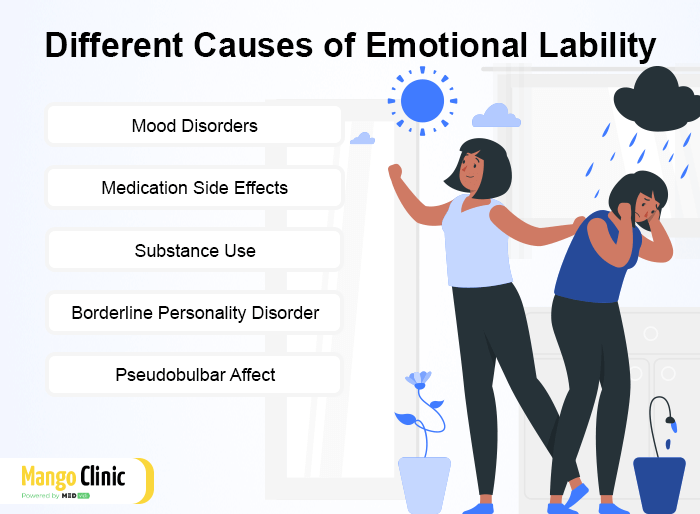
In selected cases, family therapy may be necessary to help support the patient and manage the condition. Still, patients benefit immensely through supportive treatment where therapists act as an objective guide, assisting the patient in managing complicated feelings. Sometimes competent therapists introduce dialectical behavior therapy as a quick means of stabilizing a patient. Remember that the main objective of dialectical treatment is to help a person better tolerate distress and improve their quality of life. Emotional lability patients need to find a treatment plan that works best for them. Some people may need medication to help stabilize their moods, while others may benefit more from therapy. It is crucial to find a treatment team that includes a doctor and therapist to help successfully manage the condition.
How Can You Make Psychotherapy More Effective?
Psychotherapy is a therapeutic practice that combines various techniques with the therapist’s expertise and knowledge to treat clients struggling with emotional problems. With all these practices and ways of treating patients, one must consider factors that contribute to its effectiveness like the therapist-client relationship, the patient’s willingness to change, therapy setting, and the type of therapy used. Vital rules patients need to follow include:
- Be an active participant in the process
- Practice honesty and open-mindedness to your therapist and share fears, thoughts, and progress
- Avoid drug and alcohol abuse and other mood-altering substances
- Follow the therapist’s instructions to the letter
- Embrace pleasurable activities like hobbies during therapy to quicken the recovery period
- Write about your experiences with therapy. This helps in the process of self-discovery and awareness.
- Avoid being judgmental to suggested management plans too early in the therapy
- Follow suggested guidelines in between sessions
- Use the support network available to you, including family and friends
- Never suffer in silence and seek professional support when necessary
Finally, do not expect 100% improvement after a couple of weeks of therapy – it takes time for a person’s behavior and emotions to change. The success of therapy depends on the patient’s dedication to making and sustaining changes.
Proper counseling can help you to tolerate distress. Click the button below to book your appointment.
Tips on How to Pick the Best Therapist
Choosing a therapist requires careful consideration because not all are the right fit for every person. Here are basic questions you need to ask yourself before the hunting process:
- Do I feel safe discussing personal information with this person?
- Does this person practice a therapy that I am interested in?
- Is this person available when I need them?
What Is the Best Way to Choose a Therapist?
A patient’s comfort in working with a specific therapist contributes significantly to therapy success. It is essential to feel safe discussing personal information with your therapist. Other crucial details before concluding on a therapist include:
- Treatment approaches used
- Location of practice
- Waiting time between sessions
- Phone number availability during emergencies
- Licensure status and experience level
- Affordability and whether they accept payment from insurance providers
- Also, do they offer follow-ups or other special services such as virtual appointments
What You Should Do Before Choosing a Therapist?
- Don’t limit your choice based on price alone, but also consider the therapist’s fee structure, including potential discounts for patients paying out-of-pocket.
- Please do not base your choice of therapist on their race, gender, or other physical characteristics.
- Finding a competent therapist can be daunting, especially if you are looking for an experienced person with proven results. It is advisable to go through referrals from family and friends to know someone who has had a positive experience with therapy. You may also check out reputable review sites to get an idea of what other patients are saying about the therapist you are considering.
Support Groups
Support groups are beneficial because they provide a safe place for people to share their experiences with others going through the same thing. It allows patients to support one another instead of feeling isolated and alone.
Counseling
Counseling is a lengthy therapy that requires a patient’s patience to succeed. Since it is considered one of the ancient methods, there are plenty of success stories associated with it. Counseling for emotional lability aims to help the person learn how to regulate their emotions, tolerate distress, and improve their quality of life.
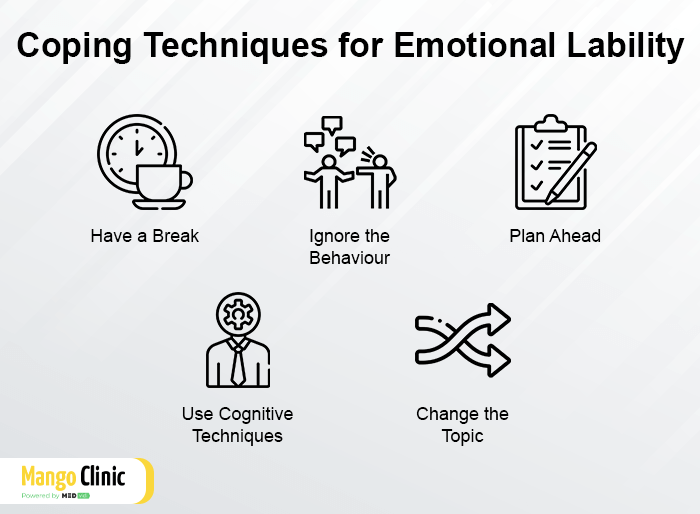
How Do You Deal with Emotional Lability on Your Own? Quick Self-Coping Skills for Emotional Lability
Use Relaxation Techniques
Relaxation exercises help individuals unwind, relax and balance emotions. Also, they improve sleeping challenges like insomnia. There are several types of relaxation techniques likely to help you deal with emotional lability. Progressive muscle relaxation, guided imagery, and mindfulness meditation are some of the most popular techniques.
How to Do Relaxation Exercises?
Sit without crossing your legs and arms, and close your eyes. Focus on breathing in and out slowly while counting down from ten to one. If you feel an unpleasant emotion looming over you, practice mindfulness by focusing on the present instead of changing the feeling. Simply accept it along with the bodily sensations it brings (like a racing heart and sweaty palms).
These strategies can help you distract yourself from getting caught up in the moment and stop ruminating over things. Additionally, they enable slowing down of breathing and heartbeat, allowing the mind and body to relax. Ultimately, relaxation allows individuals to communicate more effectively and remain calm even when experiencing unpleasant feelings such as sadness or anger.
A mental health therapist can get you out of ADHD and emotional dysregulation. Click the button below to book your appointment.
Learn Your Triggers
It is easier to avoid it when you know what triggers your emotional behavior. Try to focus on positive thoughts instead of dwelling on the negative ones. Give yourself time out for some quiet time isolated from chatter and noise when you feel overwhelmed with difficult emotions to manage. Write down all of your thoughts; this can help you understand your feelings and identify any patterns. Common set off for emotional lability are stressful environments, fatigue, demanding relationships, anxiety, and discussion of sensitive topics.
Take a Break from a Stressful Environment
Stress can make you irritable and overwhelmed, so it’s important to find some spare time. If you are in a situation that prompts negative emotions, leave until you feel better. Then educate the surrounding people about your condition to adjust to how you may act or react when in certain situations.
Self-Care
Self-care is integral to emotional lability treatment. It is vital not to neglect yourself if you want to recover from emotional lability. Although you may feel stressed and overwhelmed, taking care of your health can help overcome this condition.
Breathing Exercises
It is not always easy to block an emotional turmoil attack. Slow, deep breathing can force you to concentrate on the present moment. It also promotes relaxation by minimizing your heart rate and reducing tension in your muscles.
Ignore the Attacks
This technique is often used to stop obsessive thoughts. If you can, try to distract yourself with another activity or thought. This will help the emotion pass instead of letting it grow in your head. The best distraction is talking to a reliable person. Sharing your thoughts with loved ones can help them understand you and make you feel better. It can also relieve the burden of carrying the emotions around by yourself.
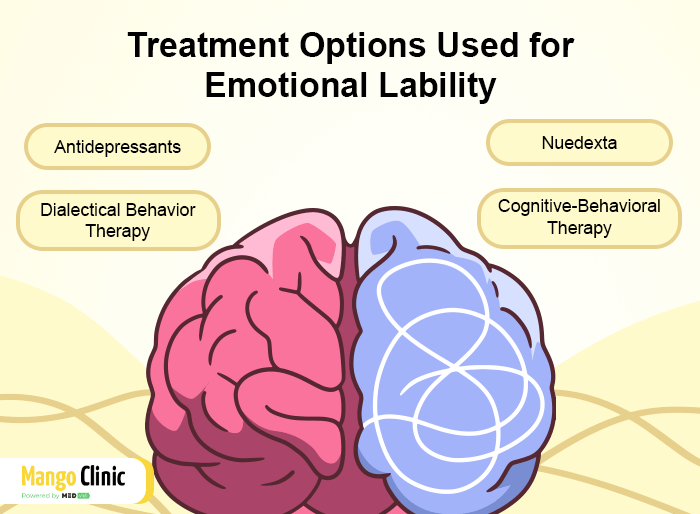
Educate Yourself and Other People on the Condition
Educating oneself on dealing with emotional lability is a great way to gain control over the condition. The more you know about emotional lability, the better equipped you become in managing it. It is also essential to educate your loved ones on how to help in case you get an attack. This way, they will understand your behavior and not take it personally. Plan relaxing activities like hiking or playing cards with your loved ones to reduce triggers if need be. Then between activities, take a rest and focus on the progress done on the recovery journey.
Face Challenges Head-on
Do not shy away from complex tasks just because you are emotionally unstable. Tackling challenges can help you build resilience and learn to cope with difficult emotions. In short, stay positive, focus on the good, and try to manage your triggers. With time and effort, you can overcome emotional lability.
Self-Compassion
This involves being kind and understanding yourself better during difficult times. Accepting your emotions and feeling the pain that comes with them can be difficult, but it is an important step in recovering from emotional lability.
Final Thoughts
Untreated emotional lability can cause a myriad of issues if not monitored. The condition can be distressing but easily managed with proper care. Remember that emotional lability is a medical diagnosis and not a term describing normal mood swings. That said, if you experience intense or prolonged emotional reactions that disrupt your life, it is crucial to seek professional help. A therapist will work with you to find the best way to manage your emotions and improve your quality of life.
Contact us at Mango Clinic for emotional lability treatment or click the banner below to book your appointment.









